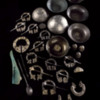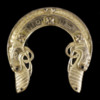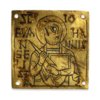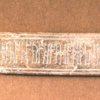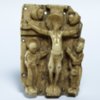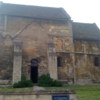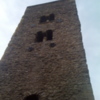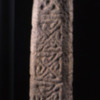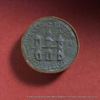Browse Items (110 total)
- Tags: Religion
Sort by:
St Ninian's Isle treasure
A Pictish treasure hoard discovered in 1958 on St Ninian's Isle, Shetland, buried beneath a stone slab marked with a cross, on what is believed to be the site of an early chapel. The hoard consists of various items of silver metalwork, some pieces…
Tags: Archaeology, Hoard, NMS, Pictish, Religion, Silverwork
Scabbard-chape
National Museums of Scotland, inventory no. FC 282. Scabbard-chape -- Three piece U-shaped casting; silver, gilding and blue glass; 8.1cm max width.
Terminates in two stylised beast heads, each trapping a small fish-like creature in its jaws.…
Terminates in two stylised beast heads, each trapping a small fish-like creature in its jaws.…
Tags: Archaeology, Art history, Hoard, Pictish, Religion, Weapons
Gold Plaque
AN00032720_001_l. Almost square gold plaque with an attachment hole at each corner. A niello-inlaid line acts as a border on the lower three sides, but the blank area around each hole indicates that they were filled by a circular bossed rivet. The…
Tags: Archaeology, Art history, British Museum, Gold, Inscription, Religion
Runic Plaque
AN00474850_001_l. Bone rectangular plaque or mount with incised runic inscription "God saves by his mercy Hadda who wrote this" and interlace. All these images are © Trustees of the British Museum. These free low-resolution images are covered also…
Tags: Archaeology, Bone, British Museum, Inscription, Religion, Runes
Plaque
AN00013974_001_l. Walrus ivory sub-rectangular plaque, broken away along the right-hand edge. Eight attachment holes survive along the edges. The surface is highly polished, and carved in high relief with a crucifixion group. Christ in a loincloth…
Tags: Archaeology, Art history, British Museum, Ivory, Religion
Anglo-Saxon Church Bradford-on-Avon
Various photographs of the St Laurence church at Bradford-on-Avon. Features tend to suggest a later date (10th/11th century) but it has been suggested that this was St Aldhelm's church of c. 700AD. It seems likely that some of the fabric survives…
Tags: Archaeology, Architecture, Building, Church, Religion, Stonework
St Michael at the North Gate Church Tower - Oxford
Situated on the northern wall of the old city of Oxford this tower dates from the early to mid eleventh century. It is stone and shows signs of reworking but wonderfully illustrates some classic saxon stone features. The tower is square, unlike the…
Tags: Archaeology, Architecture, Building, Church, Religion, Stonework
Late Saxon Cross Shaft from Exeter
The granite shaft is decorated with simple interlaced patterns, broadly datable to the 10th or 11th centuries. It would formerly have been surmounted by a head in the form of a cross. Six such cross-shafts survive in Devon, the others being at…
The first seal of the Cathedral Chapter
The seal shows the front of a church. The earliest example of its use is on a document of 1133. At that date Exeter's Norman cathedral’s towers would not have been built, and the old Saxon cathedral was still standing.
The depiction could show…
The depiction could show…
Stained Glass in Anglo-Saxon England
From Videmus, the online magazine for medieval stained glass (http://www.vidimus.org/index.html): This feature supports the launch of a major campaign by the Wearmouth – Jarrow Partnership to have the remains of two Anglo-Saxon monasteries at…

